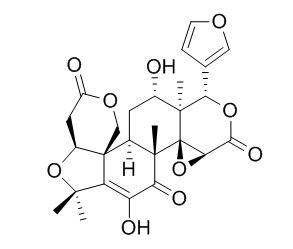12alpha-Hydroxyevodol
Reference standards.
Inquire / Order:
manager@chemfaces.com
Technical Inquiries:
service@chemfaces.com
Tel:
+86-27-84237783
Fax:
+86-27-84254680
Address:
1 Building, No. 83, CheCheng Rd., Wuhan Economic and Technological Development Zone, Wuhan, Hubei 430056, PRC
Providing storage is as stated on the product vial and the vial is kept tightly sealed, the product can be stored for up to
24 months(2-8C).
Wherever possible, you should prepare and use solutions on the same day. However, if you need to make up stock solutions in advance, we recommend that you store the solution as aliquots in tightly sealed vials at -20C. Generally, these will be useable for up to two weeks. Before use, and prior to opening the vial we recommend that you allow your product to equilibrate to room temperature for at least 1 hour.
Need more advice on solubility, usage and handling? Please email to: service@chemfaces.com
The packaging of the product may have turned upside down during transportation, resulting in the natural compounds adhering to the neck or cap of the vial. take the vial out of its packaging and gently shake to let the compounds fall to the bottom of the vial. for liquid products, centrifuge at 200-500 RPM to gather the liquid at the bottom of the vial. try to avoid loss or contamination during handling.
LWT2024, v208:116677
Theranostics.2023, 13(9):3103-3116.
Separations2023, 10(11), 567;
Nutrients2020, 12(2):488
Food Science&Tech. Res.2022, 28(2):123-132.
Int J Mol Sci.2022, 23(20):12516.
Inflammation2015, 38(1):445-55
J Nat Med.2020, 74(1):65-75
J Pharm Biomed Anal.2017, 140:274-280
Antioxidants (Basel).2021, 10(10):1620.
Related and Featured Products
Analytical Letters, 2014, 47(6):911-922.
Characterization of the Traditional Chinese Medicine Yuhuanglian by HPLC-ESI-MS.[Reference:
WebLink]
As increasing numbers of people worldwide are using traditional Chinese medicines, their characterization has become increasingly critical. This study describes the development of a facile and reproducible high-performance liquid chromatography-based method to obtain the fingerprint of the traditional Chinese medicine Yuhuanglian.
METHODS AND RESULTS:
First, similarity analysis and Principal Component Analysis (PCA) were investigated to interpret differences in the chromatograms of samples from different groups. Seven fingerprint peaks were identified by electrospray ionization tandem mass spectrometry (ESI-MS/MS), including magnolforine, coptisine, berberin, epiberberin, dehydroevodiamine, 12α-hydroxylimonin, and 12α-hydroxyevodol(12alpha-Hydroxyevodol).
CONCLUSIONS:
The established fingerprint method was then applied to the analysis of Evodiae Fructus, Coptis Rhizoma, Yuhuanglian, and analogs of Yuhuanglian, which reflected their chemical constituent properties.
The proposed method provides a technical platform for the characterization of Yuhuanglian, which will ensure the safe and effective use of this traditional Chinese medicine.



